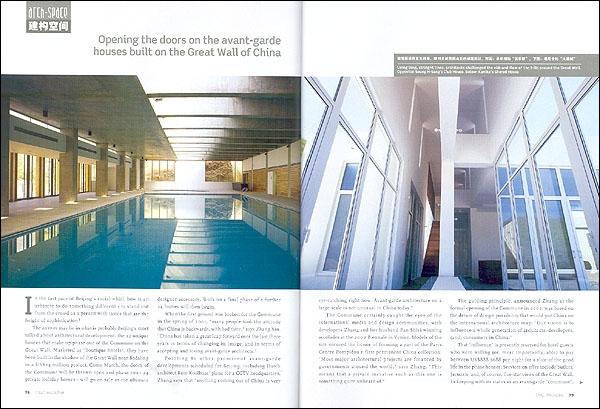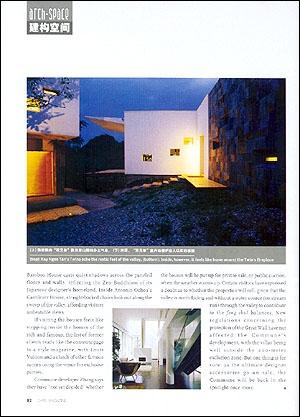
In the fast pace of Beijing's social whirl, how is an urbanite to do something different - to stand out from the crowd as a person with tastes that are the height of sophistication?
The answer may lie in what is probably Beijing's most talked about architectural development: the 12 unique houses that make up phase one of the Commune on the Great Wall. Marketed as "boutique hotels", they have been built in the shadow of the Great Wall near Badaling in a US$24 million project. Come March, the doors of the Commune will be thrown open and phase two - 24 private holiday homes - will go on sale as the ultimate designer accessory. Work on a final phase of a further 24 homes will then begin.
When the first ground was broken for the Commune in the spring of 2001, "many people took the attitude that China is backwards, with bad taste," says Zhang Xin. "China has taken a great leap forward over the last three years in terms of changing its image, and in terms of accepting and loving avant-garde architects."

Pointing to other prominent avant-garde developments scheduled for Beijing, including Dutch architect Rem Koolhaas' plans for a CCTV headquarters, Zhang says that "anything coming out of China is very eye-catching right now. Avant-garde architecture on a large scale is not unusual in China today."
The Commune certainly caught the eyes of the international media and design communities, with developers Zhang and her husband Pan Shiyi winning accolades at the 2002 Biennale in Venice. Models of the site secured the honor of forming a part of the Paris Centre Pompidou's first permanent China collection. "Most major architectural projects are financed by governments around the world," says Zhang. "This means that a private initiative such as this one is something quite unheard of."
The guiding principle, announced Zhang at the formal opening of the Commune in 2002, was based on the dream of design possibility that would put China on the international architecture map: "Our vision is to influence a whole generation of architects, developers, (and) consumers in China."
That "influence" is presently reserved for hotel guests who were willing (or, more importantly, able) to pay between US$888-1088 per night for a slice of the good life in the phase houses. Services on offer include butlers, Jacuzzis, and, of course, five-star views of the Great Wall. In keeping with its status as an avant-garde "commune", none of the houses have private gardens, and non-resident visitors are encouraged to stroll along the valley.
The development is being sold as "collectable" architecture, rather than mere real estate properties - intended to appeal to connoisseurs of structural design looking to buy into something unique. Some of the biggest names in architecture from the region were recruited to design the buildings that now nestle into the hillsides, including Gary Chang (Hong Kong SAR), Shigeru Ban, Rocco Yim (Hong Kong SAR) and Antonio Ochoa (PRC). "Most of the architects we used are individually well known in Asia," says Zhang. "But this is the first time that they've come together as a group."
The original plans for interior design were to incorporate the works of up-and-coming local designers; in the end, international names like Matthew Hilton, Von Robinson, Thierry Hoppe, and Serge Mouille were recruited to furnish the spaces.

Step inside the houses, and one begins to understand where the appeal lies in collectable architecture. Wide-open spaces are framed with large picture windows offering green views of the Great Wall's valleys, and moveable screens. Kengo Kuma's Bamboo House casts quiet shadows across the paneled floors and walls, reflecting the Zen Buddhism of its Japanese designer's homeland. Inside Antonio Ochoa's Cantilever House, straight-backed chairs look out along the sweep of the valley, affording visitors unbeatable views.
If visiting the houses feels like stepping inside the homes of the rich and famous, the list of former clients reads like the contents page to a style magazine, with Louis Vuitton and a clutch of other famous names using the venue for exclusive parties.
Commune developer Zhang says they have "not yet decided" whether the houses will be put up for private sale, or public auction, when the weather warms up. Certain visitors have expressed a doubt as to whether the properties will sell, given that the valley is north facing and without a water source (no stream runs through the valley to contribute to the feng shui balance).
New regulations concerning the protection of the Great Wall have not affected the Commune's development, with the villas being well outside the 200-meter exclusion zone. But one thing is for sure: as the ultimate designer accessories go on sale, the Commune will be back in the spotlight once more.





